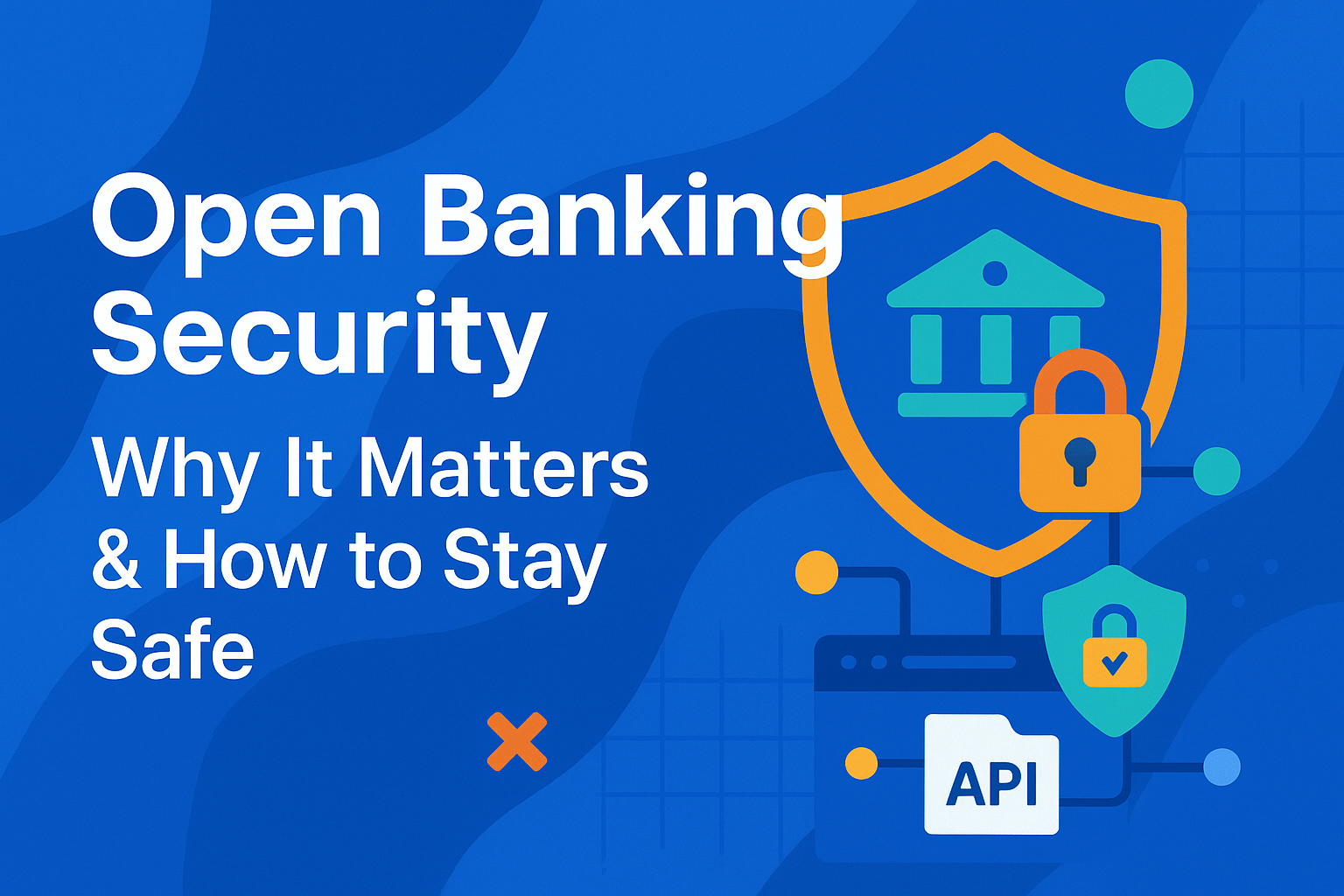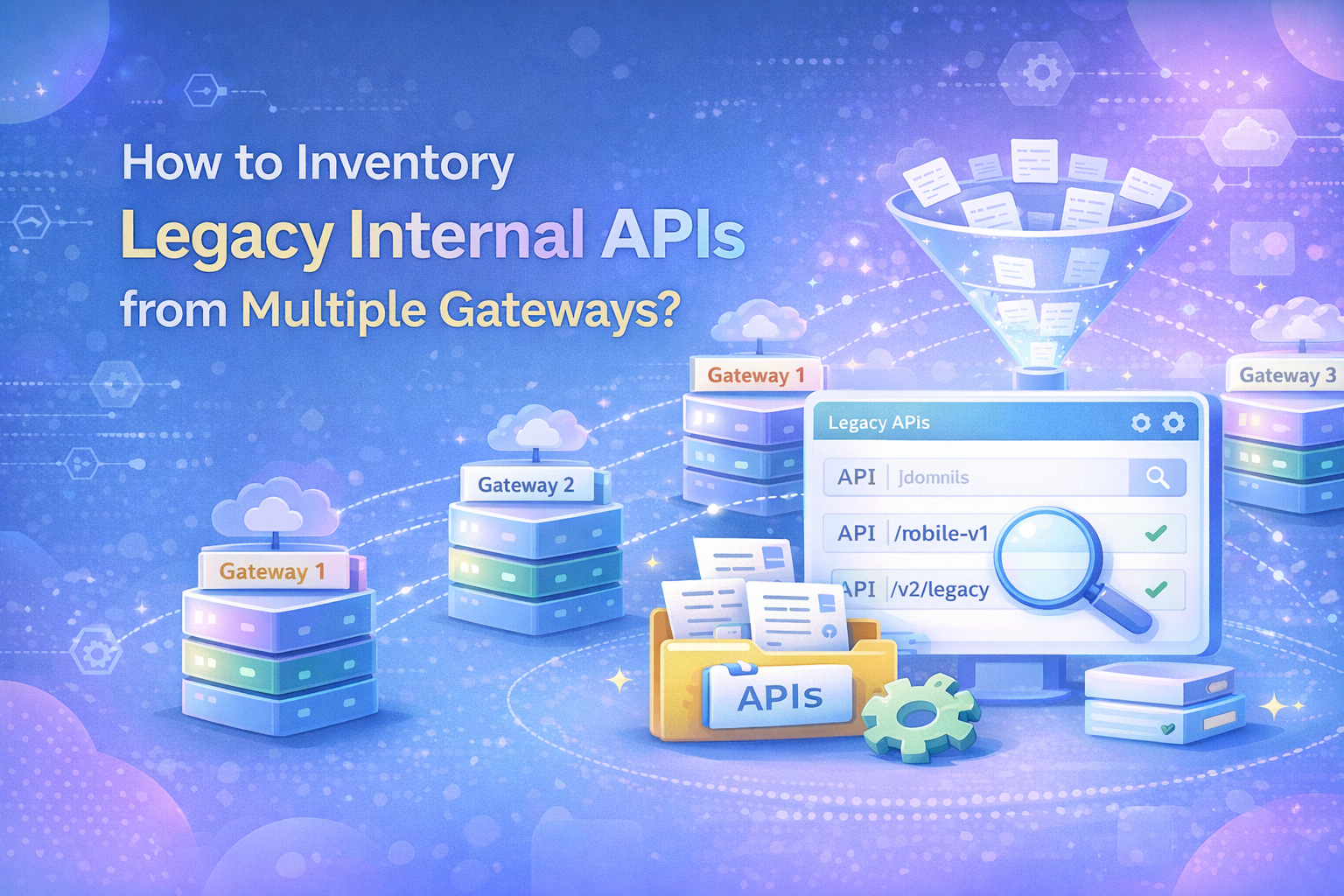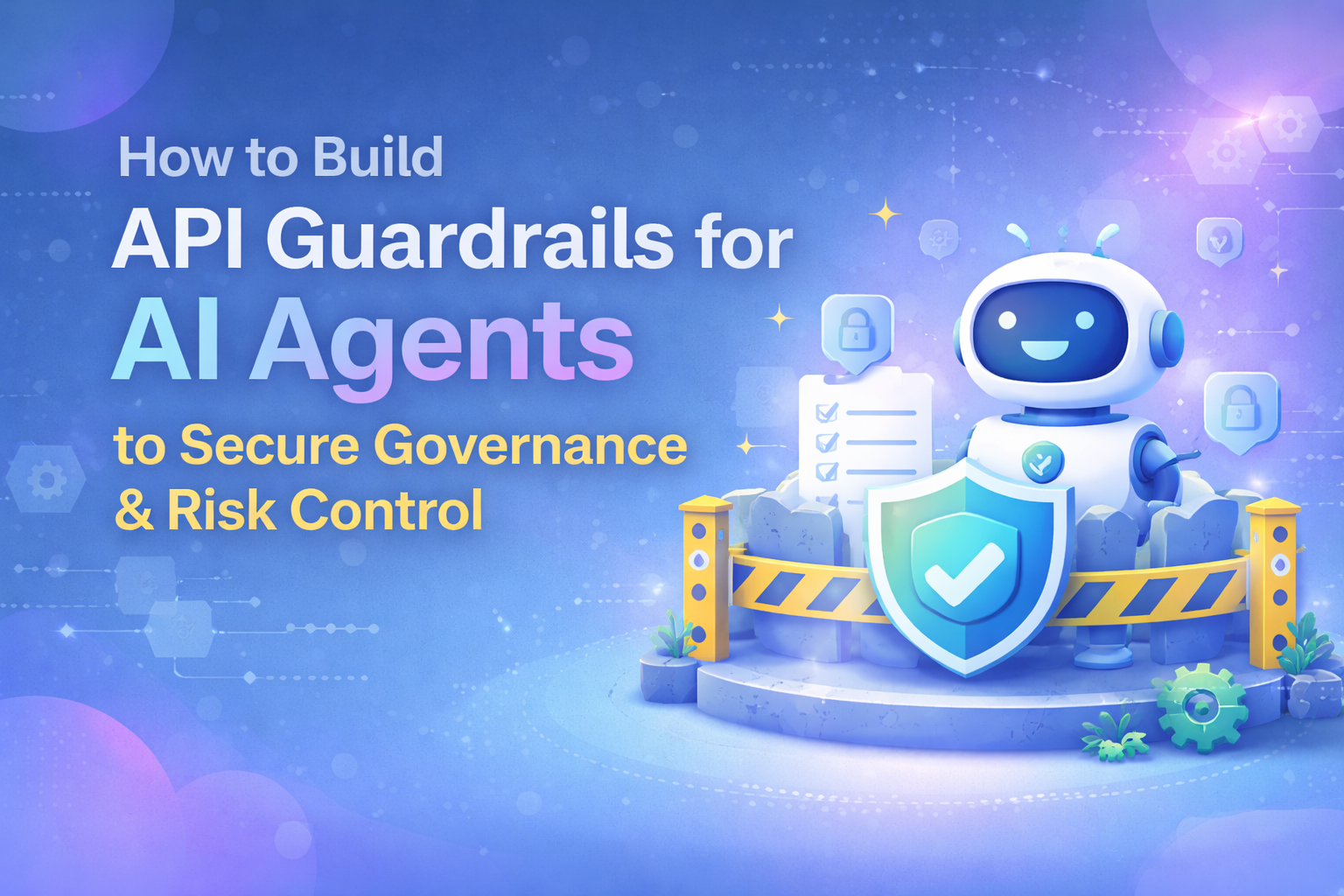
Imagine handing over your financial data to a third party only to discover it’s been leaked, stolen, or misused. With open banking revolutionizing how we manage money, convenience comes at a price: security risks that could cost you more than just money.
The open banking market is exploding, set to hit $123.7 billion by 2031, but rapid growth brings bigger targets for hackers. Weak API security, flawed authentication, and careless data handling leave millions vulnerable. And here’s the kicker: 55% of customers would leave their bank after just one fraud incident.
So, how do you stay protected? This guide dives into open banking security, why it’s crucial, core security layers, and best practices to keep yourself protected.
What is open banking security?
Open banking security is all about keeping your financial data safe when it's shared between your bank and approved third-party apps. It involves strict controls that make sure only trusted services can access your information and only for the purpose you’ve agreed to.
This level of security relies on secure APIs, strong user authentication, and regulatory checks like GDPR or PSD2 in Europe. Banks and third parties must prove they’re authorized, use encrypted connections, and follow data protection rules. In short, open banking security is a mix of tech, policy, and trust designed to give you control without putting your data at risk.
Why is security critical in open banking?
Security is critical in open banking because it safeguards sensitive customer data, prevents fraud, ensures regulatory compliance, and maintains customer trust. Without robust security, the entire open banking ecosystem, built on data sharing between financial institutions and third-party providers, can become vulnerable to breaches, manipulation, and misuse, undermining innovation and customer confidence.
Here are the key reasons why organizations must ensure strong open banking security:
1. Protecting sensitive customer data
At the core of open banking is the secure sharing of customer data, everything from account balances and transaction histories to personal identifying information. This transparency can empower users to manage their finances better through budgeting tools or lending apps. However, it also opens the door to significant privacy risks.
In traditional banking, data stays mostly within one institution. Open banking, however, involves a complex web of APIs and third-party providers (TPPs). Every handoff of data—whether it's a mobile app fetching account info or a payment service requesting transaction details—introduces a potential vulnerability.
If a single API endpoint isn’t adequately secured, hackers could gain access to large volumes of customer data. Worse still, in the absence of proper encryption and authentication, a man-in-the-middle attack could intercept and manipulate this data in real time.
2. Preventing fraud
Security lapses in open banking can also lead to financial fraud. When sensitive customer data or login credentials fall into the wrong hands, it can lead to unauthorized transfers, account takeovers, and fraudulent purchases.
Unlike traditional banking systems, where fraud detection mechanisms are often internal, open banking introduces new players, many of whom are not financial institutions. These third-party providers may not always have mature cybersecurity frameworks, making them prime targets for hackers.
APIs can also be exploited. If poorly implemented, attackers might bypass authentication mechanisms, escalate privileges, or launch denial-of-service (DoS) attacks.
3. Maintaining trust
Trust is fragile in finance, and once broken, it’s incredibly hard to restore. Customers must believe that their data is safe and that their banks, and by extension, their third-party apps, have their best interests at heart.
In open banking, customers are asked to give permission to share their banking data with unfamiliar providers. If these providers are compromised or if a security incident occurs, even if minor, the backlash can affect not only the third party but also the originating bank.
Open banking security focuses on strong authentication (like biometric login or OAuth-based token systems), monitoring systems, and transparency in data-sharing policies; hence, banks can reinforce their credibility and show customers that security isn’t an afterthought.
4. Ensuring compliance
Open banking isn’t optional in many parts of the world. It’s mandated by law. The EU’s PSD2 directive, for example, requires banks to allow licensed TPPs access to customer data, but only with the customer’s explicit consent. In return, it mandates that all parties implement robust security frameworks.
Besides regulatory fines, non-compliance can also bring reputational damage, customer attrition, and in extreme cases, loss of banking licenses.
For instance, a UK-based FinTech was fined over £21 million in 2022 after it failed to implement adequate financial crime controls. The regulator cited insufficient monitoring of third-party data access and a lack of user consent mechanisms as the key failures.
Core security layers in open banking
Open banking's security framework is built on several critical layers that work together to protect sensitive financial information. These include multi-factor authentication, authorization protocols like OAuth 2.0, encryption of data at all stages, tokenization, API security through gateways, regulatory compliance, explicit user consent, and real-time monitoring. Together, these pillars form a strong foundation for trust, transparency, and data protection.
Here is an in-depth look at these open banking security layers:
1. Authentication and authorization
Before anyone accesses your financial data, they need to prove they’re legit. Open banking uses multi-factor authentication (MFA), where one needs a password plus a fingerprint or a one-time SMS code to access your data.
Authorization goes a step further and implements OAuth 2.0, the gold standard. Think of it like a valet key for your car: third-party apps get limited access (e.g., only reading transactions, not moving money) and only for as long as you allow.
Without these checks, fraudsters could easily impersonate you. MFA and OAuth ensure that even if a hacker gets one piece of your login info, they’re stopped at the next gate.
2. Encryption for protecting data in transit and at rest
Here, your financial data is encrypted both in transit and at rest. When data moves between banks and apps, TLS (Transport Layer Security) acts like a secure tunnel. No eavesdroppers can peek inside.
Equally, for stored data, AES-256 encryption (the same standard used by governments) makes sure that even if hackers breach a database, they’ll just see gibberish without the decryption key.
3. Tokenization
Unlike encryption, which locks the real data, tokenization replaces sensitive data with a non-sensitive equivalent (a token). For example, instead of storing your actual account number, the system stores a randomly generated token. This token is useless outside of the system that created it.
So, even if someone gains unauthorized access to tokens, they can't reverse-engineer them to get your real data. This technique drastically reduces the attack surface and is widely used in payment systems to safeguard credit card details and account identifiers.
4. API security and API gateways
APIs are the digital bridges between banks and third-party services. But just like real bridges, they need toll gates and guards. This is where API gateways come in.
Acting as reverse proxies, API gateways perform several security functions. They verify identities (authentication), check permissions (authorization), and implement rate limiting to prevent abuse, like someone trying to flood the system with requests. They also scan for anomalies in traffic patterns and can block suspicious behavior in real-time.
For example, if a third-party app suddenly starts requesting thousands of customer records per minute, the gateway can flag and throttle it automatically.
5. Regulatory frameworks
In many regions, open banking is governed by regulations such as PSD2 in Europe or the Consumer Data Right (CDR) in Australia. These frameworks mandate specific security practices, including strong customer authentication, secure communication standards, and data minimization principles.
By aligning with these regulations, financial institutions and third-party providers are not just following the law but adopting best practices that reduce risk and build consumer trust.
6. Explicit customer consent
Open banking platforms must obtain explicit consent from users before accessing their data. This usually comes in the form of a clear prompt: “Do you authorize App X to access your account balance?”
This layer adds transparency and ensures users know exactly who is accessing their information and why. It also gives them the power to revoke access at any time, reinforcing their control over personal financial data.
7. Monitoring and incident response
Even with strong locks on every door, there’s always the chance of someone trying to break in. That’s why continuous monitoring and incident response plans are essential.
Monitoring tools log every access request, flag abnormal behavior (like logins from unusual IP addresses), and generate alerts for potential breaches. If something does go wrong, a structured incident response plan ensures quick containment, damage control, and user notification.
Regulatory standards and compliance in open banking security
Open banking relies on strict regulatory standards like PSD2, GDPR, FAPI, NextGenPSD2, UK Open Banking, and Strong Customer Authentication (SCA) to ensure secure data sharing between banks and third-party providers. These measures protect consumers, prevent fraud, and foster trust in open banking ecosystems.
Here’s a breakdown of the major ones, and see how each contributes to safeguarding open banking systems.
1. PSD2 (Payment Services Directive 2)
The PSD2 directive, introduced by the European Union, is the backbone of open banking in Europe. It requires banks to open their payment services and customer data, but only with the customer's explicit consent to licensed third-party providers (TPPs) via secure APIs.
PSD2 shifts the security model from screen scraping to API-based access, which is significantly more secure. APIs allow better control, monitoring, and restrictions on how and what data is shared. In addition, TPPs must be registered and regulated, meaning unauthorized players can’t access sensitive financial information.
2. GDPR (General Data Protection Regulation)
Although not specific to open banking, GDPR plays a pivotal role by regulating how personal data, especially financial data, is handled. It gives individuals significant control over their data.
The regulation demands explicit, informed consent before any personal data can be processed or shared. This ensures that customers remain in full control of their financial information. They can also revoke access at any time, which compels banks and fintechs to build systems that are flexible and privacy-focused.
3. FAPI (Financial-grade API)
Developed by the OpenID Foundation, FAPI is a security profile built on top of OAuth 2.0. It was created specifically for high-risk data environments like financial services.
FAPI ensures robust authorization and identity verification mechanisms. It minimizes risks such as token hijacking and man-in-the-middle attacks by enforcing best practices like TLS (Transport Layer Security), secure scopes, and proof-of-possession tokens.
FAPI-compliant APIs are harder to exploit, which reduces the attack surfaces that cybercriminals often target. Essentially, it provides a fortified channel for open banking transactions and data sharing.
4. Berlin Group’s NextGenPSD2
The Berlin Group (a European banking standards body) created NextGenPSD2 to standardize API integrations under PSD2. Without common rules, every bank’s API would work differently, which can lead to chaos.
This framework keeps Europe’s open banking system secure, scalable, and interoperable.
5. UK Open Banking Framework
The UK has taken an even more structured approach. The Open Banking Implementation Entity (OBIE) developed a detailed framework including API specifications, security profiles, and governance standards.
The UK’s framework is known for its rigorous testing and certification processes. TPPs must go through a detailed onboarding process and adhere to strict operational and security guidelines.
In the UK, API access is tightly controlled. Banks must expose only specific datasets, and even then, only if the user has granted permission. The framework also promotes data transparency, giving users clear insights into how and where their data is used.
6. Strong customer authentication (SCA)
SCA is a mandatory component of PSD2, but its impact is so critical that it deserves its own section. The rule is simple: to access sensitive data or make a payment, the user must prove their identity using at least two of the following:
- Something they know (password/PIN)
- Something they own (phone/token)
- Something they are (biometrics)
SCA significantly reduces fraud in open banking. Passwords alone are no longer enough. Even if one factor is compromised, attackers still need a second or third to gain access. This is particularly effective against phishing and account takeover attempts.
Common open banking security threats
Open banking has revolutionized financial services by enabling seamless data sharing between banks and third-party providers. But with innovation comes risk, as cybercriminals are constantly looking for weaknesses to exploit. The most common threats include data breaches, API vulnerabilities, fraud, third-party risks, account takeovers, phishing, denial-of-service (DoS) attacks, and man-in-the-middle attacks. Let’s break these down in detail.
1. Data breaches and fraud
Open banking thrives on data sharing, but this also makes it a goldmine for hackers. A single weak link, like an insecure third-party API, can expose millions of customer records. And once fraudsters steal data, they manipulate it.
Synthetic identity fraud (where criminals combine real and fake data to create new identities) is rising. Once they gain access, they can drain accounts, apply for loans, or even launder money. All under the victim’s name.
For instance, in June 2024, Evolve Bank & Trust, an issuer for FinTech platforms like Mercury, Wise, and Affirm, fell victim to a LockBit cyberattack. Data belonging to at least 7.6 million individuals was exposed, including names, Social Security numbers, birth dates, contact info, and account IDs.
2. API vulnerabilities
APIs are the glue holding open banking together, but they’re also a frequent point of failure. Vulnerabilities in APIs, such as injection attacks, broken authentication, or inadequate rate limiting, can be exploited by attackers to gain unauthorized access.
For example, if an API fails to verify the identity of a requesting party correctly, it could allow someone to access another user’s data. Likewise, insecure transmission of API data (e.g., without TLS encryption) can expose sensitive information during transit.
3. Third-party risks
Third-party providers (TPPs) are essential to open banking, but they also introduce significant risk. Even if a bank has strong cybersecurity practices, it cannot always control or verify the internal security posture of every TPP it connects with.
If a FinTech partner suffers a breach or is compromised by malware, attackers could potentially use its credentials or connections to infiltrate a broader network. This is often called a “supply chain attack.”
For example, in early 2025, MainStreet Bancshares revealed that roughly 4.65% of its customer base had their data stolen after a breach at a third-party service provider.
Also, onboarding TPPs too quickly without thorough vetting (due to pressure for innovation or competition) can result in trusting providers that are not adequately prepared to handle sensitive financial data.
4. Account takeover attacks
Account takeovers (ATOs) are increasingly common in open banking scenarios. If a user's login credentials are stolen via phishing, credential stuffing, or malware, an attacker can take control of their financial accounts.
In open banking, ATOs can be even more damaging. Once inside, attackers may exploit authorized connections to multiple apps and services. Imagine someone gaining access not just to your bank, but also to your budgeting app, investment dashboard, and digital wallet.
To mitigate this, banks and TPPs must implement strong authentication, such as multi-factor authentication (MFA) and behavioral biometrics.
5. Phishing and social engineering
Cybercriminals love to target humans because we’re often the weakest link. Phishing emails that mimic a bank or FinTech provider can easily trick users into revealing sensitive credentials. Social engineering has also evolved. Fraudsters might now impersonate customer service agents via phone, chat, or even fake mobile apps to extract one-time passcodes, verification links, or banking app access.
This threat persists because it's low-tech, scalable, and effective. For example, in 2024, UK Finance reported a surge in fraud where scammers tricked customers into sharing one-time passcodes (OTPs) via fake messages and websites. These attacks manipulated victims into authorizing transactions where criminals stole about £1.2bn through various types of financial fraud.
6. Denial-of-service (DoS) attacks
DoS and Distributed Denial-of-Service (DDoS) attacks aim to overwhelm APIs or backend systems, rendering them unavailable. In an open banking context, a successful DDoS attack on a key API could block multiple services at once, from payment processing to account visibility.
This isn’t just a technical inconvenience. It directly impacts user trust. If users can’t access their funds when they need them, they may question the reliability of open banking altogether.
To defend against these, implement rate limiting, load balancing, and auto-scaling systems into every layer of the API ecosystem.
Best practices to maintain risk and security in open banking
Open banking unlocks innovation but also introduces new risks. To keep data and transactions secure, financial institutions must adopt strong API security, strict authentication, third-party risk management, and proactive threat monitoring. Here’s how to stay ahead of threats while maintaining compliance and customer trust.
1. Implement robust API security
APIs are the foundation of open banking, so protecting them should be the first line of defense. One essential best practice is hardening API security through strict vulnerability management. This includes limiting exposure by minimizing unnecessary endpoints, implementing rate limiting to prevent abuse, and closely monitoring API usage patterns. It’s also crucial to patch known vulnerabilities promptly, as attackers often exploit old security flaws that remain unaddressed.
Organizations must also design APIs with security in mind from the outset. This means using secure frameworks, encrypting data sent and received via APIs, and following best practices in secure coding. Authorization protocols like OAuth 2.0 and authentication methods such as multi-factor authentication (MFA) aren’t just “nice-to-haves”—they're core to blocking unauthorized access.
2. Data security
Data security in open banking goes beyond just encryption. Start with encrypting all sensitive data, both in transit and at rest. Protocols like TLS ensure secure transmission between systems, while strong encryption algorithms like AES safeguard stored data.
However, encryption alone isn’t enough. Implement role-based access controls and data masking to limit visibility of sensitive information internally as well.
Equally important is respecting user data rights. Open banking must operate on explicit, informed consent from customers. Users should always know who has access to their data, for what purpose, and for how long.
Beyond that, they should be able to revoke that access instantly. Data integrity is another crucial piece: digital signatures and hashing techniques can confirm that information hasn’t been altered, intentionally or otherwise, during transmission or storage.
3. Third-party risk management
The open banking model thrives on collaboration, but with that comes third-party risk. That’s why due diligence before onboarding any third-party provider is non-negotiable.
Institutions need to assess the provider's security controls, past breaches (if any), adherence to data protection standards, and overall reliability. Requesting SOC 2 reports, penetration test results, or certifications like ISO 27001 can help evaluate the vendor's security posture.
But due diligence doesn’t stop at onboarding. Ongoing monitoring is vital. Use automated tools to check that partners continuously meet your security standards. Periodic audits, security scorecards, and even simulated breach exercises can reveal if any third-party systems have become a weak link.
Remember, a chain is only as strong as its weakest link—and in open banking, that weak link could very well be a partner you trust.
4. Other essential practices to maintain risk and security in open banking
- Incident response planning: Don’t wait for a breach to start thinking about how to respond. Develop, test, and update incident response plans regularly to ensure a fast, coordinated approach when threats materialize.
- Real-time monitoring and threat detection: Set up systems to detect anomalies in real time, such as unusual API call volumes or location-based access patterns. Early detection can make the difference between a contained incident and a full-blown breach.
- Regulatory compliance: Align your systems and processes with major regulations like PSD2, GDPR, and any local financial authority guidelines. Compliance not only avoids penalties but also helps in building trust and standardizing security practices.
- Zero trust policies: Adopt a Zero Trust model that assumes no entity, whether internal or external, can be trusted by default. Enforce strict identity verification and granular access controls at every layer of your system.
Secure your open banking transactions and activities with Digital API
As mentioned above, APIs are the digital bridges in open banking; hence, you must keep them protected at all times. This requires a robust API management platform, such as DigitalAPI.
The platform offers a robust, enterprise-grade API management solution designed to secure your open banking transactions end-to-end. Its core strength lies in API Security, where automated linting, OWASP checks, and enforceable policies ensure vulnerabilities are detected early, guaranteeing compliance and protection at scale.
Through its API Hub, DigitalAPI centralizes your API catalogue across gateways or clouds to enhance governance, track usage, and eliminate redundancies with AI-powered discovery workflows.
For API key-based access, DigitalAPI automates secure key generation, encrypted storage, rotation, usage monitoring, API rate limiting, and rapid revocation—all visible via analytics and logs to support compliance and breach detection.
Finally, DigitalAPI’s open banking sandbox environment enables testing of simulated accounts and payment flows in isolated, compliant conditions to ensure real-world security before deployment.
Ready to secure your open banking processes? Book a demo here to get started today!
FAQs
1. How does open banking use OAuth 2.0 and OpenID Connect for security?
Open banking utilizes OAuth 2.0 to securely grant third-party applications access to financial data without requiring password sharing. OpenID Connect adds identity verification, ensuring users are who they claim to be. Together, they create a trusted handshake between users, banks, and apps, which reduces fraud while keeping control in the user’s hands.
2. What are the best practices for API security in an open banking ecosystem?
To secure APIs, banks should use strong authentication (like mutual TLS), rate limiting, and proper input validation. Regular audits, token expiration, and encrypted data flows help prevent misuse. APIs should follow the principle of least privilege, only sharing what's necessary. Clear documentation and regular testing can also catch vulnerabilities early.
3. How is open banking security different across the UK, EU, and US?
The UK and EU enforce stricter open banking security through regulations like PSD2, which mandates strong customer authentication and licensed APIs. In contrast, the US lacks a federal framework, so banks set their own rules. That regulatory gap makes the US ecosystem more fragmented and potentially riskier.
4. What kind of monitoring is required for secure open banking transactions?
Effective monitoring tracks every API call, flags anomalies, and logs user activity in real time. Banks should look for unusual access patterns or failed login attempts. Automated alerts and behavior analytics help stop threats before they spread. Without constant monitoring, even the strongest security setup can quietly fail.
5. What are the security issues with open banking?
Open banking’s main security risks include poor API implementation, weak third-party vetting, phishing attacks, and data leakage. Trusting external apps with sensitive data increases the attack surface. If a single link in the chain is weak, say, an insecure app or unpatched server, it can expose customer information to cybercriminals.
You’ve spent years battling your API problem. Give us 60 minutes to show you the solution.
.svg)

%20(1).png)





